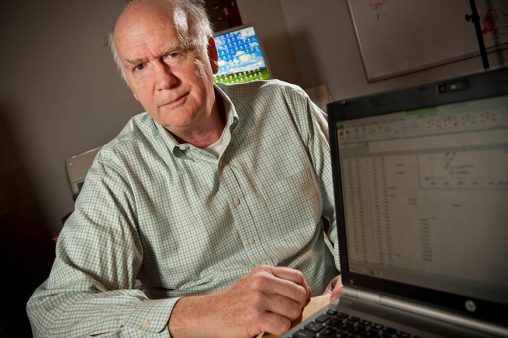
Wright State physics professor Allen Hunt developed a mathematical model that can more precisely predict the degree of global warming by measuring soil production.
A new mathematical model that can be used to more precisely predict the degree of global warming by measuring soil production has been developed by Wright State University physics professor Allen Hunt.
The model is outlined in a paper titled “Percolation theory for solute transport in porous media: Geochemistry, geomorphology and carbon cycling.” The paper has been published in Water Resources Research, a journal of the American Geophysical Union founded in 1964.
“This new model gives us a better quantitative handle on what the carbon changes in the atmosphere in the future will be,” Hunt said. “It provides a basis for giving more reliable input into climate change scenarios.”
When soil production increases through chemical weathering, more carbon dioxide and nitrogen dioxide are absorbed into the soil from the atmosphere. That in turn reduces those greenhouse gases, which many scientists believe are causing global warming and resulting in the melting of the polar icecaps and changing weather patterns.
Conversely, erosion and the reduction of soil results in increased carbon dioxide and nitrogen oxide in the atmosphere, which could cause more global warming.
Hunt said the new model predicts soil production by measuring the weathering process — the percolation of water into and through the soil — over time.
“This is something that is completely new,” he said. “This is something that is not generated by any other theoretical approach. It does so by predicting accurately the transport of weathering reactants, including CO2, and weathering products. Our treatment is completely different from other models. Models typically have hundreds of parameters that need to be evaluated. We only have two, and they can be independently established.”
“Moreover,” he added, “the same formula predicts not only chemical weathering and soil formation rates, but also the rate of sequestration (deposition) of both carbon and nitrogen in the soil, over time periods up to 60 million years and through climate variability from the world’s driest to the wettest.”
Typically, soil production is high in rainforests, where there is a lot of precipitation, and low in deserts.
“It depends on how much water comes through the soil and reaches the bottom,” he said. “So we should now be in position to figure out soil production rates in any climate.”
Hunt said data from the entire world should now be analyzed using his theory in order to generate worldwide predictions of drawdown of atmospheric CO2 as well as soil carbon sequestration.
“We will have to do a global analysis,” he said. “We can then take the data and make a global prediction on how the atmosphere’s carbon content is going to change.”
Being able to predict soil production also helps with soil conservation, protecting crops, preventing landslides and forecasting changes in the landscape, said Hunt, who is currrently teaching a class on geomorphology, the study of land surfaces.
Last year, Hunt released a book that revealed a new mathematical tool that promises to offer important insights into global warming by predicting the influence of soil on vegetation growth.
The book — “Networks on Networks: The Physics of Geobiology and Geochemistry” — was written by Hunt and Stefano Manzoni of Stockholm University’s Bolin Centre for Climate Research, and published by Britain’s Institute of Physics.
The book shows that it is necessary to understand connections within water and solute transport paths from the soil through the roots and stems to the canopy, and from the pore scale up. By linking micro- and macro-scales, it provides a coherent framework to understand scale-dependent hydrologic, biogeochemical and ecological processes. The research was funded by the National Science Foundation.
The American Geophysical Union is a nonprofit organization of geophysicists consisting of over 62,000 members from 144 countries. The geophysical sciences include atmospheric and ocean sciences, solid-Earth sciences, hydrologic sciences and space sciences.

 Wright State’s annual Raidersgiving draws hundreds
Wright State’s annual Raidersgiving draws hundreds  Wright State named a Best for Vets College
Wright State named a Best for Vets College  Wright State’s Boonshoft School of Medicine receives full continuing accreditation from Liaison Committee on Medical Education
Wright State’s Boonshoft School of Medicine receives full continuing accreditation from Liaison Committee on Medical Education  Wright State supports deaf and hard of hearing community with Deaf Festival
Wright State supports deaf and hard of hearing community with Deaf Festival  Wright State students showcase scientific discoveries at annual research festival
Wright State students showcase scientific discoveries at annual research festival 